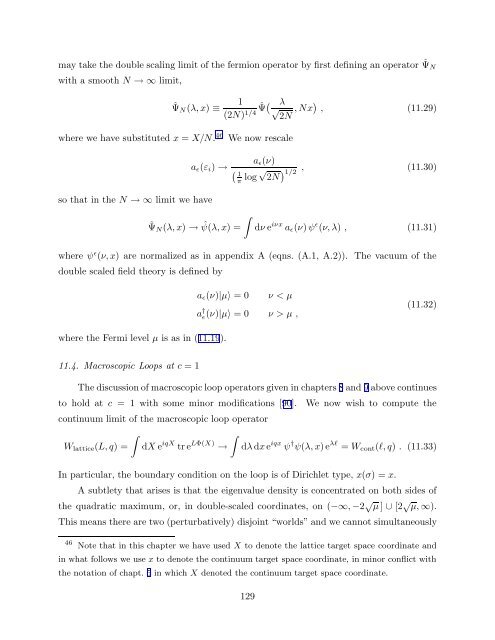arXiv:hep-th/9304011 v1 Apr 5 1993
arXiv:hep-th/9304011 v1 Apr 5 1993
arXiv:hep-th/9304011 v1 Apr 5 1993
You also want an ePaper? Increase the reach of your titles
YUMPU automatically turns print PDFs into web optimized ePapers that Google loves.
may take <strong>th</strong>e double scaling limit of <strong>th</strong>e fermion operator by first defining an operator ˆΨ N<br />
wi<strong>th</strong> a smoo<strong>th</strong> N → ∞ limit,<br />
1 ( λ<br />
ˆΨ N (λ, x) ≡ ˆΨ √ , Nx ) , (11.29)<br />
(2N)<br />
1/4 2N<br />
where we have substituted x = X/N. 46 We now rescale<br />
a ɛ (ε i ) →<br />
a ɛ (ν)<br />
( 1<br />
π log √ 2N ) 1/2 , (11.30)<br />
so <strong>th</strong>at in <strong>th</strong>e N → ∞ limit we have<br />
∫<br />
ˆΨ N (λ, x) → ˆψ(λ, x) =<br />
dν e iνx a ɛ (ν) ψ ɛ (ν, λ) , (11.31)<br />
where ψ ɛ (ν, x) are normalized as in appendix A (eqns. (A.1, A.2)). The vacuum of <strong>th</strong>e<br />
double scaled field <strong>th</strong>eory is defined by<br />
a ɛ (ν)|µ〉 = 0 ν < µ<br />
(11.32)<br />
a † ɛ (ν)|µ〉 = 0 ν > µ ,<br />
where <strong>th</strong>e Fermi level µ is as in (11.19).<br />
11.4. Macroscopic Loops at c = 1<br />
The discussion of macroscopic loop operators given in chapters 8 and 9 above continues<br />
to hold at c = 1 wi<strong>th</strong> some minor modifications [90]. We now wish to compute <strong>th</strong>e<br />
continuum limit of <strong>th</strong>e macroscopic loop operator<br />
∫<br />
∫<br />
W lattice (L, q) = dX e iqX tr e LΦ(X) → dλ dx e iqx ψ † ψ(λ, x) e λl = W cont (l, q) . (11.33)<br />
In particular, <strong>th</strong>e boundary condition on <strong>th</strong>e loop is of Dirichlet type, x(σ) = x.<br />
A subtlety <strong>th</strong>at arises is <strong>th</strong>at <strong>th</strong>e eigenvalue density is concentrated on bo<strong>th</strong> sides of<br />
<strong>th</strong>e quadratic maximum, or, in double-scaled coordinates, on (−∞, −2 √ µ ] ∪ [2 √ µ, ∞).<br />
This means <strong>th</strong>ere are two (perturbatively) disjoint “worlds” and we cannot simultaneously<br />
46 Note <strong>th</strong>at in <strong>th</strong>is chapter we have used X to denote <strong>th</strong>e lattice target space coordinate and<br />
in what follows we use x to denote <strong>th</strong>e continuum target space coordinate, in minor conflict wi<strong>th</strong><br />
<strong>th</strong>e notation of chapt. 5 in which X denoted <strong>th</strong>e continuum target space coordinate.<br />
129
















